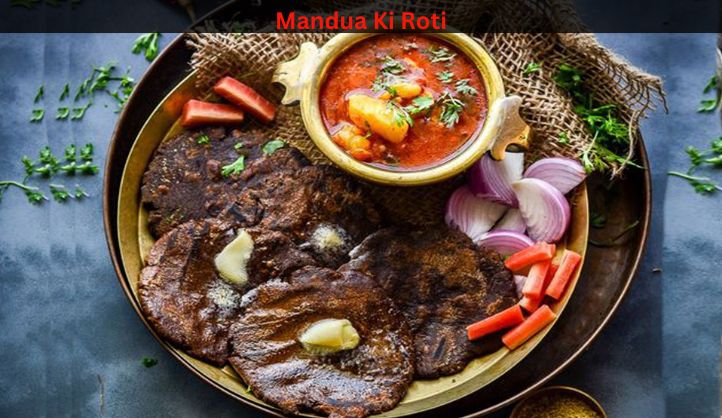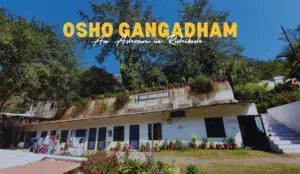Nestled in the foothills of the Himalayas, Uttarakhand offers a unique culinary experience. Among its many delicious staples is Mandua ki roti, a flatbread made from finger millet flour, also known as Mandua or Ragi. This simple dish is a cornerstone of Kumaoni and Garhwali cuisine, the two main regions of Uttarakhand, and holds a special place in the hearts (and stomachs) of the people there.
A Grain for the Mountains
Mandua is a particularly resilient grain that thrives in the harsh Himalayan climate. It requires minimal water to grow and packs a powerful nutritional punch. Rich in calcium, protein, and dietary fiber, Mandua ki roti is a healthy and filling option, perfect for the active mountain lifestyle.
The Art of Making Mandua ki Roti
Traditionally, the flour for Mandua ki roti is ground between stones. Today, commercially available flour is often used. The dough is slightly different from regular roti dough. Since Mandua flour doesn’t contain gluten, the dough is denser and requires a bit more water to knead. Sometimes, wheat flour is mixed in for added elasticity.
The rotis are typically thicker than their wheat counterparts and cooked on a tava (griddle) over an open fire. They are often served hot, smeared with ghee (clarified butter) and enjoyed with a variety of regional curries like Bhatt ki daal (made from black lentils) or Aloo Tamatar (potato and tomato).
More Than Just Food
Mandua ki roti is more than just a meal; it’s a symbol of the region’s culture and heritage. The process of making the rotis is often a communal affair, bringing families and communities together. The earthy flavor and robust texture of the rotis are a comforting reminder of the land and the people who cultivate it.
A taste of Uttarakhand
For those seeking an authentic taste of Uttarakhand, Mandua ki roti is a must-try. It’s a delicious and nutritious dish that offers a glimpse into the heart of the Himalayas. So, next time you’re looking for a unique and flavorful flatbread, look no further than Mandua ki roti.
Some Other Dishes of Uttarakhand
Kafuli
Kafuli is a popular winter dish and is a stew made with spinach, fenugreek leaves, and other seasonal greens. It’s a hearty and nutritious option, perfect for the colder months.
Bhang Ki Chutney
This Bhang ki chutney is a unique accompaniment made from hemp seeds, coriander leaves, and spices. It has a pungent, nutty flavor and is said to have digestive benefits.
Phaanu
Phaanu is a stir-fry dish that is typically made with radish or other seasonal vegetables. It’s a light and flavorful option that showcases the fresh produce of the region.
Aloo Ka Jhol
Aloo ka jhol is a simple flavorful curry made with potatoes, tomatoes, and spices. It’s a versatile dish that can be enjoyed with rice or roti.
Kandali Ka Saag
Kandali ka Saag dish features the unique flavor of the Kandalee plant, a type of wild creeper. It’s a slightly bitter dish that is believed to have medicinal properties.
Chainsoo
Chainsoo is stir-fry dish made with locally available green leafy vegetables like nettles or spinach. It’s a simple and healthy option that is often served with rice.
Jhangore Ki Kheer
Jhangore ki kheer is a sweet dish made with Jhangora, a type of millet. It’s a creamy and delicious pudding that is perfect for a satisfying end to a meal.
Kumauni Raita
Kumauni Raita is a refreshing side dish made with yogurt, cucumber, and spices. It’s a perfect accompaniment to spicy curries.
Gulgule
Gulgule is sweet dumplings made with khoya (milk solids) and deep-fried. They are then soaked in a sugar syrup and served hot.
FAQs About Mandua ki Roti
1. What is Mandua ki Roti?
Mandua ki Roti is a flatbread originating from Uttarakhand, India. It’s made from finger millet flour (also called Mandua or Ragi) and is a staple food in the Kumaoni and Garhwali regions.
2. What are the health benefits of Mandua ki Roti?
Mandua flour is packed with nutrients! Here are some reasons why Mandua ki Roti is a healthy choice:
- Rich in Fiber: Aids digestion and keeps you feeling full for longer.
- Gluten-Free: Perfect for those with gluten sensitivities.
- High in Calcium: Promotes strong bones and teeth.
- Good Source of Iron: Helps prevent anemia and fatigue.
3. How is Mandua ki Roti different from regular roti?
- Flour: Made from finger millet flour instead of wheat flour.
- Texture: Denser and slightly thicker than regular roti due to the lack of gluten.
- Flavor: Earthy and nutty flavor compared to the wheatier taste of regular roti.
4. How do I make Mandua ki Roti?
The basic recipe involves kneading Mandua flour with water to form a dough, rolling it out, and cooking it on a hot griddle. Some variations include mixing in some wheat flour or adding spices. A quick web search for “Mandua ki Roti recipe” will provide you with detailed instructions.
5. What do I eat with Mandua ki Roti?
It pairs well with a variety of dishes, including
- Curries: Bhatt ki daal (black lentil), Aloo Gutti (potato with sun-dried tomatoes), seasonal vegetable curries.
- Ghee: Adds richness and complements the nutty flavor.
- Jams and Chutneys: Sweet or spicy options for a flavor contrast.





